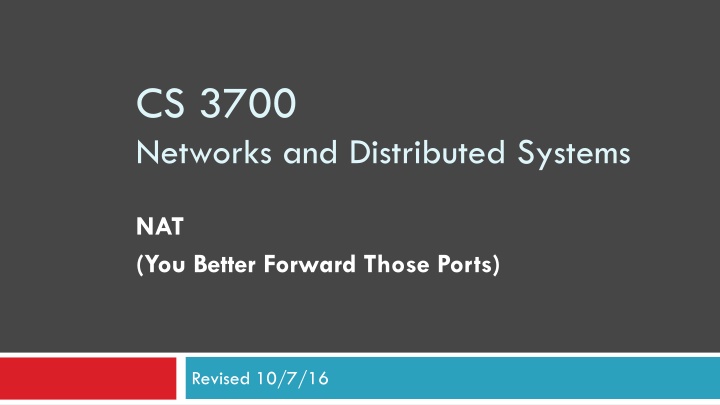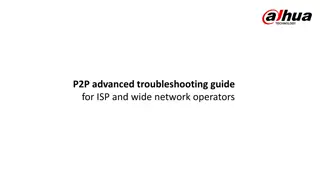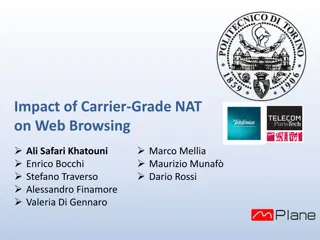
Network Address Translation (NAT) in Computer Networks
Learn about the concept of Network Address Translation (NAT) in computer networks, the IPv4 shortage problem, private IP networks, basic NAT operation, and the advantages of NAT. Discover how NAT enables multiple devices to share a single IP address and allows seamless communication between private networks and the Internet.
Uploaded on | 2 Views
Download Presentation

Please find below an Image/Link to download the presentation.
The content on the website is provided AS IS for your information and personal use only. It may not be sold, licensed, or shared on other websites without obtaining consent from the author. If you encounter any issues during the download, it is possible that the publisher has removed the file from their server.
You are allowed to download the files provided on this website for personal or commercial use, subject to the condition that they are used lawfully. All files are the property of their respective owners.
The content on the website is provided AS IS for your information and personal use only. It may not be sold, licensed, or shared on other websites without obtaining consent from the author.
E N D
Presentation Transcript
CS 3700 Networks and Distributed Systems NAT (You Better Forward Those Ports) Revised 10/7/16
The IPv4 Shortage 2 Problem: consumer ISPs typically only give one IP address per-household Additional IPs cost extra More IPs may not be available Today s households have more networked devices than ever Laptops and desktops TV, bluray players, game consoles Tablets, smartphones, eReaders How to get all these devices online?
Private IP Networks 3 Idea: create a range of private IPs that are separate from the rest of the network Use the private IPs for internal routing Use a special router to bridge the LAN and the WAN Properties of private IPs Not globally unique Usually taken from non-routable IP ranges (why?) Typical private IP ranges 10.0.0.0 10.255.255.255 172.16.0.0 172.31.255.255 192.168.0.0 192.168.255.255
Private Networks 4 192.168.0.1 192.168.0.1 Private Network Private Network 192.168.0.2 192.168.0.2 NAT Internet NAT 192.168.0.0 71.2.33.56 192.168.0.0 66.31.210.69
Network Address Translation (NAT) 5 NAT allows hosts on a private network to communicate with the Internet Warning: connectivity is not seamless Special router at the boundary of a private network Replaces internal IPs with external IP by modifying packet headers This is Network Address Translation May also replace TCP/UDP port numbers Maintains a table of active flows Outgoing packets initialize a table entry Incoming packets are rewritten based on the table
Basic NAT Operation 6 Private Network Internet Source: 192.168.0.1:2345 Dest: 74.125.228.67:80 Source: 66.31.210.69:2345 Dest: 74.125.228.67:80 Private Address Public Address 192.168.0.1:2345 74.125.228.67:80 192.168.0.1 66.31.210.69 74.125.228.67 Source: 74.125.228.67:80 Dest: 192.168.0.1:2345 Source: 74.125.228.67:80 Dest: 66.31.210.69:2345
Advantages of NATs 7 Allow multiple hosts to share a single public IP Allow migration between ISPs Even if the public IP address changes, you don t need to reconfigure the machines on the LAN Load balancing Forward traffic from a single public IP to multiple private hosts
Natural Firewall 8 Private Network Internet Private Address Public Address 192.168.0.1 66.31.210.69 74.125.228.67 Source: 74.125.228.67 Source: 74.125.228.67 Dest: 192.168.0.1 Dest: 66.31.210.69
Concerns About NAT 9 Performance/scalability issues Per flow state! Modifying IP and Port numbers means NAT must recompute IP and TCP checksums Breaks the layered network abstraction Breaks end-to-end Internet connectivity 192.168.*.* addresses are private Cannot be routed to on the Internet Problem is worse when both hosts are behind NATs What about IPs embedded in data payloads?
Port Forwarding 10 Private Network Internet Private Address Public Address 192.168.0.1:7000 *.*.*.*:* 192.168.0.1 66.31.210.69 74.125.228.67 Source: 74.125.228.67:8679 Dest: 192.168.0.1:7000 Source: 74.125.228.67:8679 Dest: 66.31.210.69:7000
Hole Punching 11 Problem: How to enable connectivity through NATs? NAT 1 NAT 2 192.168.0.2 192.168.0.1 59.1.72.13 66.31.210.69 Two application-level protocols for hole punching STUN TURN
TURN 14 Traversal Using Relays around NAT NAT 1 NAT 2 192.168.0.2 192.168.0.1 Please connect to me on 66.31.210.69:7000 192.168.0.1:7000 192.168.0.2:7000 59.1.72.13 66.31.210.69 TURN Server






















